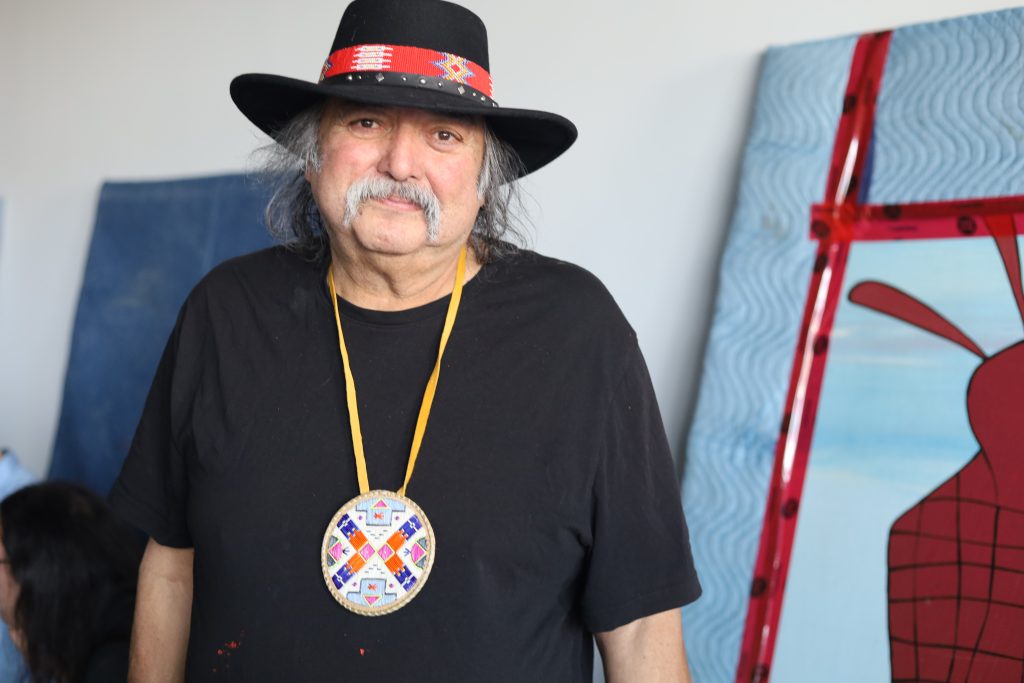The opening line of the official biography of Mi’kmaq artist Alan Syliboy reads: “Alan Syliboy grew up believing native art was generic.” “In the sense that, you know, Indians on TV. We all have headdresses, and we all ride horses. Right?” says Syliboy from his eponymous art studio, which opened on the Millbrook reservation just outside Truro on June 1. “I’m quite different than a Cree or an Ojibwe, you know, I mean, there’s similarities and everything, but there’s a difference. And that was my goal, when I started to research: is to find what is actually Mi’kmaq and make it actually authentic Mi’kmaq. That was my goal in life.”
Syliboy, who made the Sobey Art Award shortlist this year, has been making art since the 1970s, attending NSCAD for a single school year then returning as a member of the Board of Governors some 25 years later. “I was single parent, I had three kids, and it was just impossible to do that,” he says of his abandoned degree. “But I was trying to—put it this way—break trails. So when Alice Mansell asked me to be on the board, that was a chance to do that. There was never an Indigenous person on any kind of board anywhere. So that’s why I went on all the boards that I could, and that was the reason: just to break a trail.”
When you were growing up in Millbrook what was your connection to art and what made you start making art?
I always did drawing, in school—that’s the only thing that worked for me in school. I wasn’t a very good student. I mean, I wasn’t allowed to speak my language at school. So things went badly for me and the only refuge I had was drawing so I just did that. Shirley Bear, who was a Maliseet artist from New Brunswick, was doing a program and recruited me so I spent six months learning art in in New England. And we went on the road for two or three months doing workshops on you know, native art in communities. So we’re teaching art, basically. And that’s how I got my start. So when that was over, I decided to go to NSCAD. I really didn’t have an end plan—I never have one, I never say, ‘Well, I’m going to do this and graduate,’ I never had that in my mind. I wanted to go and see what it was about, really.
The most I got from NSCAD is I was at the coffee shop about four hours a day talking to everyone I could talk to about art—people from New York and California and Tokyo. And so that was my education there. And that was the one I needed. Because that broadened my horizons.
How would you compare the experiences of studying under Shirley Bear and then going into an academic, structured environment at the school?
Well I could never get the classes that I wanted to do, because I was always late. So I got the leftovers—I went to ceramics, which I liked, but I wasn’t very good at ceramics, and then I couldn’t spend enough time in the classroom to really get anywhere with that. Homer Lord said ‘I can’t really give you a pass because everybody else put in three times as much time as you have, and I understood that. I didn’t take that personally. I was there kind of on the fringes, and it was difficult for me. I was not unhappy about what I did, but it was not possible to do more.
Shirley Bear is an Indigenous artist, and she taught me in an Indigenous way. I was around this whole process. We visited artists studios in New England, half a dozen very fine artists that taught us. So I had a good education that way. I went to Khalil Gibrand’s nephew, who was a sculptor, and he spent a day with us talking about art and how to be an artist, basically. We learned printing in New Hampshire, and we had Gerry Williams, a potter. We spent a couple of weeks with him. So that’s where a lot of my education came through hands-on basically, not structured, not really structured, like NSCAD would be.
When you talk about breaking trails on arts boards in the province, what does that mean? What does your presence on these boards mean for the organizations and what is your goal when you when you participate?
Just by being there. Many organizations didn’t want me there. But I elbowed my way in. And now they have to have [an Indigenous representative]. That’s my thinking. We were never there. We were invisible, absolutely invisible. And the NSCAD thing—I couldn’t believe, years later, we’re talking about exactly the same thing when I was there. And it was, like centuries ago, that was a little discouraging. I thought maybe we could have moved on from there. We are now, but how long did it take?

